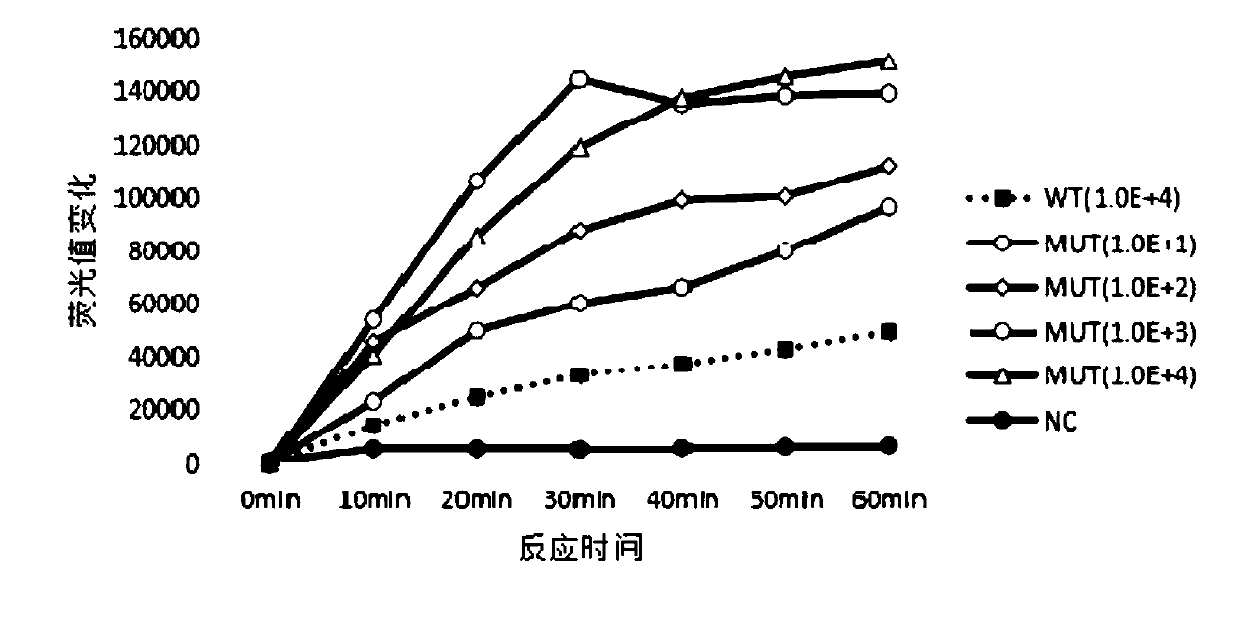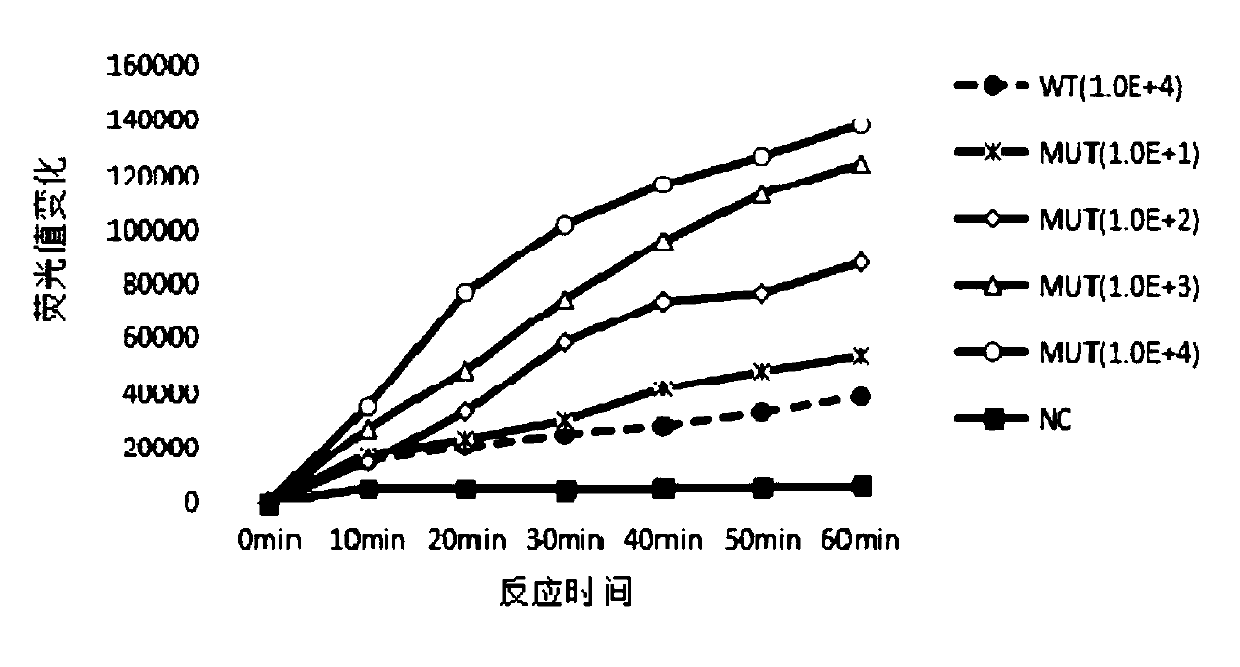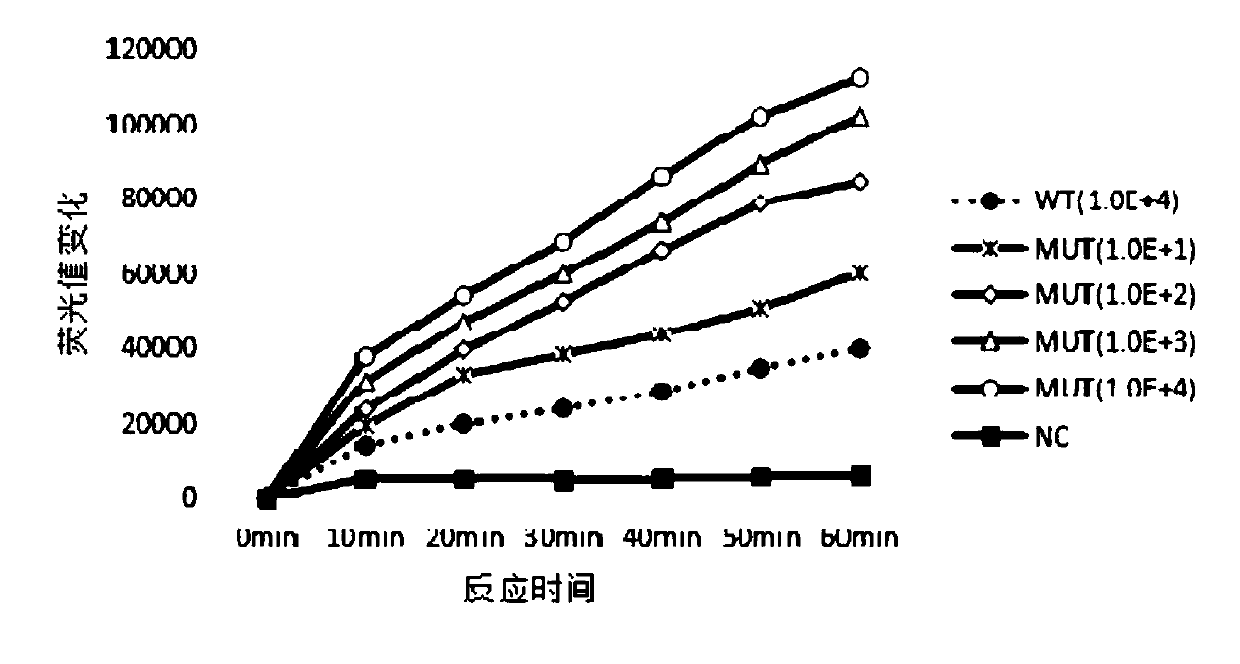Detection kit and detection method for gene mutation of lung cancer-related molecular markers
A molecular marker and detection kit technology, applied in the field of detection kits for lung cancer-related molecular marker gene mutations, can solve the problems of high detection cost, inability to apply large-scale clinical sample research, and only one gene can be detected at a time.
- Summary
- Abstract
- Description
- Claims
- Application Information
AI Technical Summary
Problems solved by technology
Method used
Image
Examples
Embodiment 1
[0052] Embodiment 1 Design and acquisition of crRNA targeting gene mutation site
[0053] 1. Discovery of lung cancer detection sites based on the CRISPR-cpf1 system
[0054] According to the latest "NCCN Guidelines", we obtained molecular marker genes commonly used in lung cancer mutation detection. According to the gene sequence and a large amount of clinical test data, the sequence of the common mutation site of the gene is determined, and the crRNA is designed for these different regions and the CRISPR / cpf1 system is constructed for research. The results show that the region sequence shown in SEQ ID NO.1-5 is used as the detection site for lung cancer mutations based on the CRISPR / cpf1 system (the bold part is the mutation region), which has a good detection effect.
[0055] Table 1
[0056]
[0057]
[0058] 2. Design of crRNA targeting gene mutation site
[0059] (1) Design principles of crRNA targeting gene mutation sites
[0060] Since the CRISPR-cpf1 system ...
Embodiment 2
[0078] Example 2 Detection Kit and Detection Method for Gene Mutations of Lung Cancer Related Molecular Markers
[0079] 1. The composition of the kit
[0080] This kit includes 5 crRNAs related to the detection of lung cancer gene mutations (crRNA of 5 mutation sites is obtained as shown in Example 1) or crDNA of 5 mutation sites (when the kit is crDNA, the operator needs to first The crDNA fragments generate RNA under the action of T7 RNA polymerase respectively, recover and purify to obtain crRNA, see Example 1 for details), a specific fluorescent probe (see Table 3 for the sequence, any one shown in SEQ ID NO.26-28 kind of probe), cpf1 protein, enzyme-free water, DNase inhibitor;
[0081] table 3
[0082]
[0083] Preferably, the kit can also include an amplification system, which includes a pair of isothermal amplification primers, wherein the sequence of the pair of isothermal amplification primers for the EGFR-T790M mutation site is shown in SEQ ID NO.29-30 The se...
Embodiment 3
[0092] Embodiment 3 mutant crRNA is to the specific detection of wild-type and mutant sequence
[0093] The target sequences of the wild strain and the mutant strain were synthesized, and the specificity was detected by using the above five mutant crRNAs respectively. The crRNAs of the five mutation sites prepared in Example 1 were respectively constructed into CRISPR-cpf1 systems to verify the cutting effectiveness in vitro.
[0094] Use 100-250nM purified cpf1, 250-500nM crRNA, 1-5μl synthetic fluorescent probe, 2μL DNase inhibitor, target DNA at different dilution concentrations, incubate in detection buffer (NEBuffer 3) at 37°C for 1-3 Hour. At the same time, a blank control was established. The blank control group is the signal group without crRNA and without cpf1 corresponding to each experimental group. Several groups of reaction mixtures were simultaneously reacted in a portable detector (the temperature was set at 37° C., and kinetic detection was performed every 1...
PUM
 Login to View More
Login to View More Abstract
Description
Claims
Application Information
 Login to View More
Login to View More - R&D
- Intellectual Property
- Life Sciences
- Materials
- Tech Scout
- Unparalleled Data Quality
- Higher Quality Content
- 60% Fewer Hallucinations
Browse by: Latest US Patents, China's latest patents, Technical Efficacy Thesaurus, Application Domain, Technology Topic, Popular Technical Reports.
© 2025 PatSnap. All rights reserved.Legal|Privacy policy|Modern Slavery Act Transparency Statement|Sitemap|About US| Contact US: help@patsnap.com



